Mind the gap (and shape your response)

Mind the gap (and shape your response)
Those of you who follow my posts might remember that just over a year ago – two days before Christmas – my wife and I were flooded out of our home (see February 2021’s post for all the watery details).
A year later and we’re not back in but as work nears completion on returning things to how they were, I’m considering whether we need to have additional flood protection for the house – such as flood barriers – for something that is unlikely to happen again in the next forty or fifty years, but still might.
Do we change our approach or simply snap back to our happy and dry pre-flood state?
It strikes me that this is a metaphor for our working relationships and the decisions we make: when something happens such as a disagreement with a colleague or a business judgement that goes awry, do these tough times cause us to learn, change a behaviour for example and move forward, or do these moments cause us to be defensive and simply accept it as a life lesson?
Using the gap between stimulus and response
My recommendation is that, in these situations, you take time to observe what happened; consider what contribution you made; and, identify whether it was a learning situation for you and how you start to imbue that learning into your way of ‘being’. My Alexander colleague Philip Goldman has written on the importance of using the gap between stimulus and response; taking a pause and noticing what you’re experiencing in a non-judgmental way.
For leaders to succeed it’s important to use that capacity to pause, to mind the gap, and use the space between the stimulus (what happened) and the response (what you’re going to do about it) to learn, and then use that learning effectively.
As for my house and whether to install flood protection for a never – I hope – to be repeated flood, I’m still firmly in the gap between stimulus and response, so your suggestions and advice would be very welcome!